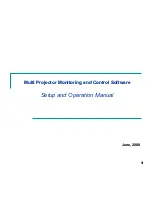
JUNOSe 10.3.1 Release Notes
30
Known Behavior
Some Juniper Networks SNMPv1-formatted traps contain an incorrect object
identifier (OID) in the SNMPv1-Trap-PDU enterprise field. An SNMPv2 trap is
typically identified by an OID that ends in the form ...x.y.z.0.n. This OID
appears, in full, as the value of the snmpTrapOID.0 object in the varbind list of
an SNMPv2-formatted trap. In the corresponding SNMPv1-formatted trap, this
OID is broken down into subcomponents that fill the SNMPv1-Trap-PDU
enterprise field (...x.y.z) and specific trap number field (n); the zero is unused.
The SNMPv1-formatted versions of the following Juniper Networks traps
incorrectly contain ...x.y.z.0 in the SNMPv1-Trap-PDU enterprise field. That is,
a zero is mistakenly appended to the correct enterprise OID value.
Work-around:
Use the OIDs that the SNMP agent sends.
SSH
If the SRP module restarts when SSH is configured in a VR other than default,
SSH can sometimes become disabled. This happens if SSH attempts to bind
with a VR before the VR comes back up after the restart. In this event, a
warning message is generated to alert you to the fact that SSH is disabled in
that VR. You must manually re-enable SSH either by accessing the console VTY
or creating a Telnet session to the router.
Stateful SRP Switchover (High Availability)
Additional processing is required to maintain and mirror the necessary state
information that enables subscriber sessions to stay up across an SRP failover.
As a result, the performance of other control plane functions is reduced.
Specifically, call setup rates are lower than in previous releases.
Trap Name
Expected Enterprise OID
Enterprise OID Sent by SNMP Agent
junidApsEventSwitchover
.1.3.6.1.4.1.4874.3.2.2.1.2
.1.3.6.1.4.1.4874.3.2.2.1.2.0
junidApsEventModeMismatch
.1.3.6.1.4.1.4874.3.2.2.1.2
.1.3.6.1.4.1.4874.3.2.2.1.2.0
junidApsEventChannelMismatch
.1.3.6.1.4.1.4874.3.2.2.1.2
.1.3.6.1.4.1.4874.3.2.2.1.2.0
junidApsEventPSBF
.1.3.6.1.4.1.4874.3.2.2.1.2
.1.3.6.1.4.1.4874.3.2.2.1.2.0
junidApsEventFEPLF
.1.3.6.1.4.1.4874.3.2.2.1.2
.1.3.6.1.4.1.4874.3.2.2.1.2.0
juniAddressPoolHighAddrUtil
.1.3.6.1.4.1.4874.2.2.21.3
.1.3.6.1.4.1.4874.2.2.21.3.0
juniAddressPoolAbatedAddrUtil
.1.3.6.1.4.1.4874.2.2.21.3
.1.3.6.1.4.1.4874.2.2.21.3.0
juniAddressPoolNoAddresses
.1.3.6.1.4.1.4874.2.2.21.3
.1.3.6.1.4.1.4874.2.2.21.3.0
juniDhcpLocalServerPoolHighAddrUtil
.1.3.6.1.4.1.4874.2.2.22.3
.1.3.6.1.4.1.4874.2.2.22.3.0
juniDhcpLocalServerPoolAbatedAddrUtil
.1.3.6.1.4.1.4874.2.2.22.3
.1.3.6.1.4.1.4874.2.2.22.3.0
juniDhcpLocalServerPoolNoAddresses
.1.3.6.1.4.1.4874.2.2.22.3
.1.3.6.1.4.1.4874.2.2.22.3.0
pimNeighborLoss
.1.3.6.1.3.61.1
.1.3.6.1.3.61.1.0
NOTE:
Rapid call setup rates are most important following an outage that causes
all subscribers to drop, because many of the dropped subscribers will immediately
attempt to reconnect. This type of outage occurs far less frequently with stateful
SRP switchover.
















































